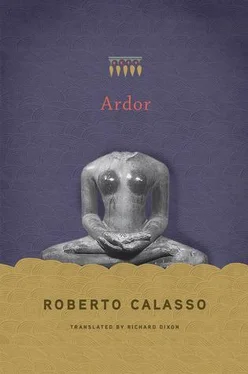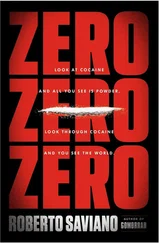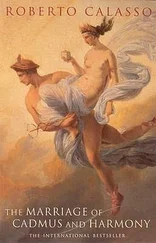* * *
In describing one sequence of the sattra , when the mahāvratīya cup, the cup of the “great vow,” is used, we read: “For what food is for men, the vow ( vrata ) is for the gods.” Here at last, in the clearest terms, we see what the gods expect of men: to feed themselves on their “vows,” to which some feel bound in relation to an invisible presence, which is nourished by that mental tension. Certainly not by the smoke and blood of sacrifices, as the theological opponents of the Vedic ritualists would one day suggest, above all the author of the Epistle to the Hebrews, who would still claim that the pagan gods, and even the God of Moses, were appeased “by the blood of goats and calves.”
* * *
The Vedic ritualists were keen to make it clear that there is no way out of sacrificing. The sacrifice is like a secret formula that has to be protected in every way from the eyes of the enemy. This is true not just for men (such an assertion would be banal and tremendously limited): it had been just the same for the gods. As they hurled themselves into their repeated and indecisive conflicts with the Asuras, the Devas thought: if we are ever defeated, where could we keep the sacrifice? (Someone must have been tormented by the same concern during the Second World War, worrying about the formulas for the atomic bomb.) Their answer: on the moon. It would have been their place of refuge in the event of being defeated on earth.
Sacrifice accompanies us everywhere. We realize this even when we look up at the moon. What are those dark spots on the lunar disk? Places of worship. This has been so since the day the Devas decided to take various sacrificial altars to the moon. They set them down on the white dust, and the marks they left were of identical proportion to those of the fine body of a woman. From there they look down on us, from there they still make signs to earth and work on its behalf. The altars were lifted in the air toward the moon while the gods said: “Lifting up the earth that gives life, before the bloody battle.” And they repeated: “Before the bloody battle.”
* * *
That the sacrifice was a “controlled catastrophe,” to use Heesterman’s vivid expression, can be seen from certain marginal observations: “The houses of the sacrificer could easily collapse behind the back of his adhvaryu , when he goes away [from the cart] with the sacrifice, and could crush the family [of the sacrificer].” Here we see the sharp, piercing sense of impermanence that must have pervaded the Vedic world. When the sacrificer starts the ceremony, he turns his back on the old world, which is nevertheless the everyday world on earth. Sucked into another space, he can ignore all he is leaving behind, in a first après moi le déluge. And the mighty void which then opens up in the world could act like a tornado that whips and crushes man’s flimsy shelters. But the sacrificer knows that one day he will have to leave the sacrifice — and he would like to leave it safe and sound, and find too that the world he had left behind is also safe and sound: above all his house. And so the sacrificer does not forget to plead: “May those who have doors remain secure on the earth!” Even if he is already swept away by the elation of roaming in the “atmosphere,” he knows that one day not only will that elation come to an end but he himself will yearn to leave it, to return to ordinary, dull, secular life, as if returning to a haven of peace.
Whether it is the celebration of an aśvamedha or a soma sacrifice, all nevertheless ends with a purifying bath. Too much tension, contamination, guilt, horror, exaltation have been concentrated around the sacrifice. Now he thinks only of freeing, ridding himself of that excess energy, of returning to being an ordinary creature who lives in untruth. To do so, the sacrificer reveals that up to that moment he has felt like the victim: the first feeling he names is that of one who is “untied from the sacrificial post.” And at the same time he gives no more weight to the sensation than someone who, feeling too hot, goes looking for cool, fresh water. So violent is the sense of liberation that his first thought is to let his clothes float away in the current. Now they float away, forever. The Vedic ritualists were certainly not worried about possessions. They made use of few objects, always as temporary vehicles, to be destroyed, abandoned, thrown away as soon as they were of no further use to the opus, to that unique sequence that appeared against the background of the invisible and flowed back to it. The only visible remains were an area of ground that had been trampled over, with ashes and charred logs and little else. Better for them to be rid of everything, starting with their own clothes, cast off like the dried skin of a snake.
* * *
One day — perhaps every day — someone woke up and conceived the “plan,” saṃkalpa , for a sacrifice. He chose a suitable place, a clearing not far from running water, on a slight slope. He drew lines on the ground, or got someone else to draw them: rectangles, trapezoids. This was the place where he would say: “Now I pass from untruth to truth.” But the ceremony didn’t involve just one person. There had to be sixteen officiants — and the sacrificer’s wife was also there. Then there was the śamitṛ , with the task of appeasing (in other words, strangling) the victims immediately outside the sacrificial area. Lastly, to celebrate a sacrifice, it had to be rewarded with the distribution of ritual fees to the officiants. If any one of these elements was absent, the sacrifice was ineffective, indeed harmful. The sacrifice turned against the sacrificer.
There was also another risk, an obstacle that could ruin the sacrifice. It was vital that no other sacrificer was celebrating his sacrifice in a place too close. The Āpastamba Śrauta Sūtra gives clear instructions in this respect: “If the distance of a day’s journey by horse, or a hill, or a river crossing the mountains separates the two sacrifices, or if there is a mountain between the two or if the sacrifices are celebrated in two different kingdoms, then there is no conflict between the two sacrifices. The text of a Kaṅkati Brāhmaṇa says: ‘There is no conflict between the sacrifices if the sacrificers are not enemies.’”
There is a certain flavor of multiple delirium about imagining a number of open spaces, each in immediate proximity to a community (which couldn’t have been numerous), where dozens of officiants were simultaneously circling around fires, reciting, singing, murmuring, each running the risk of overlapping or interfering with the others. The texts refer several times to such events, suggesting what to do, especially where the sacrificers are rivals. We can then also imagine that they are sacrificing with opposing desires, each bent upon the ruin of the other.
The desire forming the basis of the sacrifice thus meets various obstacles: it has to be capable of being formulated (to understand itself), it has to be capable of paying itself (for its own existence), it has to avoid colliding with the desires of others. The sacrifice originates from one person alone but broadens out into a community, where it can be affected by the opposing desires of others — desires that are either too close (danger of imitation) or adverse (which is why the texts continually refer to spiteful rivals ).
But the Vedic ritualists were too subtle to think that, if anyone wanted to get rid of their rival, all they had to do was celebrate their sacrifice a sufficient distance away. The rival is a perpetual presence, lurking within, wrapped up in the gestures of the officiants. Among the materials for the sacrifice — the sambhārāḥ , “utensils” required for the liturgy — there are two identical wooden spoons. The first is called the juhū , the other the upabhṛt. Both are filled with ghee. Both are brought close to the fire. But the offering is poured from only one of the spoons, while the officiant holds the other directly below, with his left hand. Why? The ritualist (in this case Yājñavalkya) gives the answer: “Certainly the sacrificer is behind the juhū and he who wishes ill is behind the upabhṛt ; and if [the officiant] should speak of two spoons, he would be letting the spiteful rival clash with the sacrificer. Behind the juhū is he who eats and behind the upabhṛt he who has to be eaten; and if [the officiant] should speak of two [spoons], he would be letting he who has to be eaten clash with he who eats. So speak of only one spoon.”
Читать дальше












